RBA Annual Conference – 2006 Global Demography: Fact, Force and Future David E Bloom and David Canning[1]
Abstract
In the past 50 years, the world accelerated its transition out of long-term demographic stability. As infant and child mortality rates fell, populations began to soar. In most countries, this growth led to falling fertility rates. Although fertility has fallen, the population continues to increase because of population momentum; it will eventually level off. In the meantime, demographic change has created a ‘bulge’ generation, which today appears in many countries as a large working-age population. This cohort will eventually become a large elderly population, in both developed and developing countries. Population growth has been the subject of great debate among economists and demographers. Until recently, most have agreed on a middle ground, in which population growth per se has no effect on economic growth. New evidence suggests that changes in the age structure of populations – in particular, a rising ratio of working-age to non-working-age individuals – leads to the possibility of more rapid economic growth, via both accounting and behavioural effects. The experiences of east Asia, Ireland and sub-Saharan Africa all serve as evidence of the effect of demographic change on economic growth (or lack thereof). Both internal migration (from rural to urban areas) and international migration complicate this picture. The overall implications of population growth for policy lie in the imperative for investments in health and education, and for sound policies related to labour, trade and retirement. Understanding future trends is essential for the development of good policy. Demographic projections can be quite reliable, but huge uncertainties – in the realms of health, changes in human life span, scientific advances, migration, global warming and wars – make overall predictions extremely uncertain.
1. Introduction[2]
For much of human history, demographic patterns were reasonably stable; human populations grew slowly, and the age structures, birth rates, and death rates of populations changed only gradually. Epidemics and pandemics had huge effects on populations, but these effects were short-lived and had little bearing on long-term trends.
In the past 50 years, however, this trend of long-term stability has given way to the biggest demographic upheaval in history, an upheaval that is still running its course. In the developed world, a sharp post-war rise in fertility was followed by an equally sharp fall. These changes in fertility transformed age structures through the creation of a ‘baby boom’ generation. The ageing of this generation and continued declines in fertility and old-age mortality are shifting the population balance in developed countries from young to old. In the meantime, the developing world has experienced a population explosion, the result of improved nutrition, public health infrastructure and medical care.
Even if high fertility – the main underlying cause of rapid population growth – were to suddenly adjust to the long-run replacement level of 2.1 children per woman, humanity would continue to experience demographic change for some time. The rapid increase in the global population over the past few decades has resulted in large numbers of people of childbearing age. This creates ‘population momentum’, in which the populations of most countries, even those with falling birth rates, will grow for many years to come. This is particularly true of developing countries.
Population changes have potentially huge implications for the pace and progress of economic development. For example, an increasing proportion of elderly may act as a drag on economic growth where smaller working populations must provide for a larger number of non-working dependents. Rising life expectancy can also bolster an economy by creating a greater incentive to save and to invest in education, thereby boosting the financial capital on which investors draw and the human capital that strengthens economies. Where a country has experienced a baby boom followed by a decline in fertility, the relative size of the workforce is increased. Countries that are able to absorb the baby boom generation into productive employment can experience a rapid increase in economic growth. Countries unable to take advantage of this opportunity run the risk of creating large, chronically underemployed and increasingly restive working-age populations.
2. Global Demographic Trends and Patterns
The global population, which stood at just over 2 billion in 1950, is 6.5 billion today. The world is currently gaining new inhabitants at a rate of 76 million people a year (representing the difference, in 2005, between 134 million births and 58 million deaths). Although this growth is slowing, middle-ground projections suggest the world will have 9.1 billion inhabitants by 2050, when growth will be approximately 34 million a year.
These past and projected additions to world population have been, and will increasingly be, distributed unevenly across the world. Today, 95 per cent of population growth occurs in developing countries (see Figure 1). The population of the world's 50 least-developed countries is expected to more than double by the middle of this century, with several poor countries tripling their population over the period. By contrast, the population of the developed world is expected to remain steady at around 1.2 billion, with population declines in some wealthy countries.
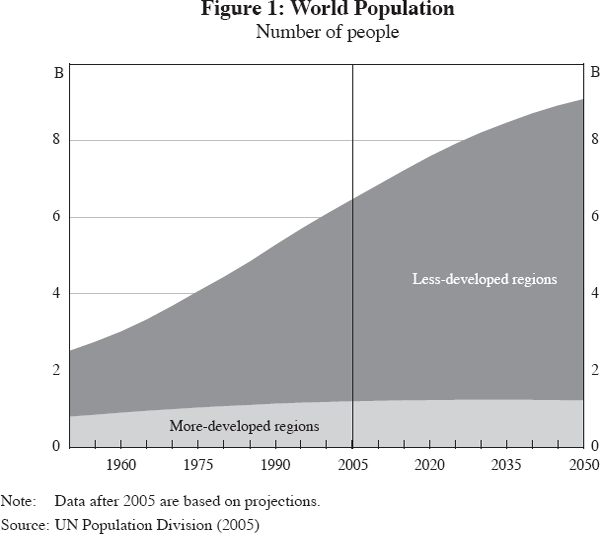
The disparity in population growth between developed and developing countries reflects the existence of considerable heterogeneity in birth, death and migration processes, both over time and across national populations, races and ethnic groups. The disparity has coincided with changes in the age-group composition of populations. An overview of these factors illuminates the mechanisms of global population growth and change.
2.1 Crude birth and death rates
One of the simplest ways to consider population growth is through crude birth and death rates. These are the number of births and deaths per 1,000 people. On a worldwide basis, the difference between these rates is the rate of population growth. Within regions or countries, population growth is also affected by emigration and immigration. Figure 2 shows that in both developed and developing regions the crude birth rate has decreased by about half over the past 50 years. This implies a much greater absolute reduction in developing regions. The net result of these reductions is a current crude birth rate in developing regions that is similar to that of the developed regions 50 years ago.
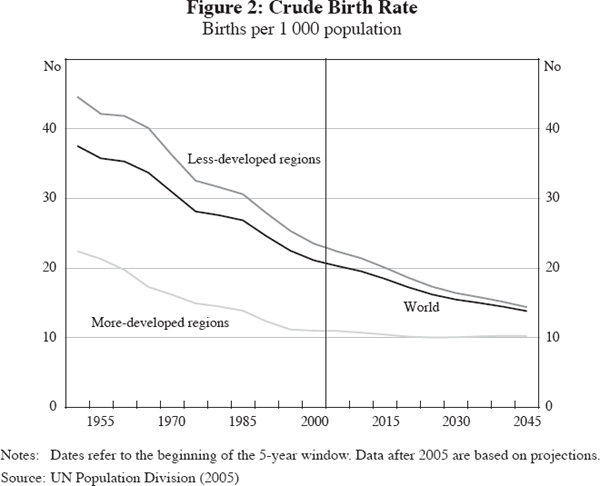
As Figure 3 shows, crude death rates follow a different pattern. The reduction in mortality in developing countries since 1950 has been very rapid – so rapid that the crude death rate in developing countries is now lower than in developed countries. The gradual rise in the crude death rate in developed countries results from the combination of relatively steady infant and child mortality rates and rising death rates due to an ageing population. The figure indicates that a similar rise in the death rate will begin in developing countries in a couple of decades.
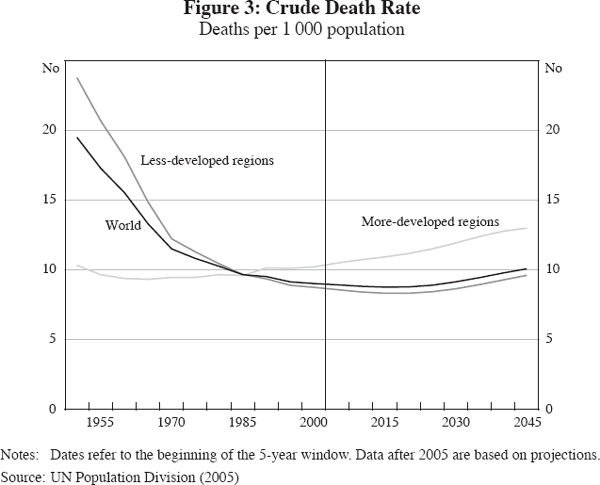
Figure 4 demonstrates the combined effect of crude birth and death rates on population growth rates, as modified by migration (primarily from developing to developed regions).
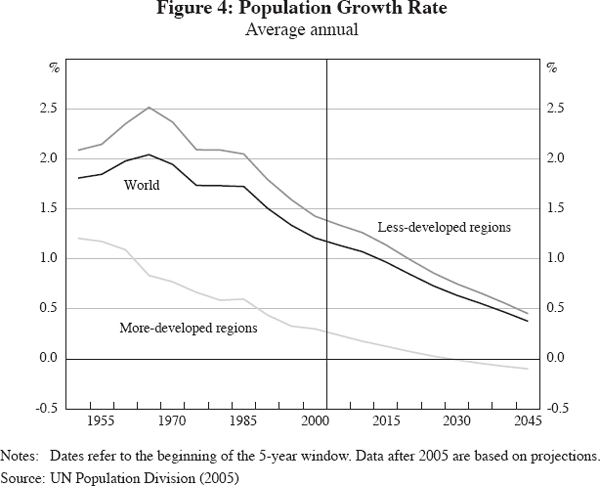
2.2 Total fertility rate
The total fertility rate, that is the number of children born per woman, fell from about 5 in 1950 to a little over 2.5 in 2005 (see Figure 5). This number is projected to fall to about 2 by 2050. This decrease is attributable largely to changes in fertility in the developing world. In 1950, the total fertility rate among developed countries was already below 3 children per woman; the rate among developing countries was over 6. Fertility in the latter is now below 3 children per woman. The fertility decline in low-income countries can be ascribed to a number of factors, including declines in infant mortality rates, greater levels of female education and increased labour market opportunities for women, and the provision of family planning services.
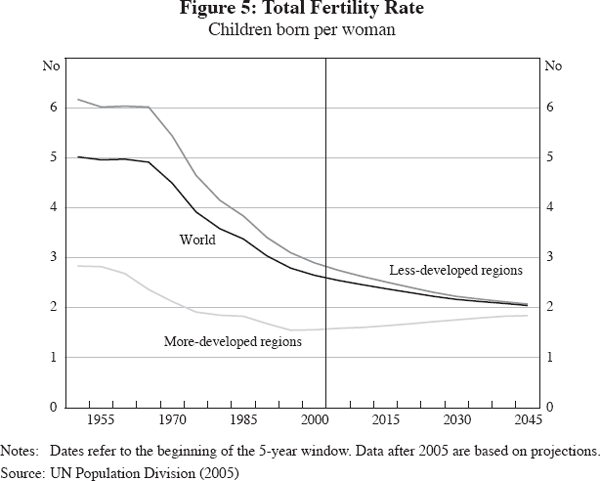
2.3 Infant and child mortality decline
The developing world has seen significant reductions in infant and child mortality over the past 50 years (see Figure 6). Infant mortality (death prior to age 1) in developing countries has dropped from 180 to about 57 deaths per 1,000 live births. It is projected to decline further to fewer than 30 deaths per 1,000 live births by 2050. The past half-century's gains resulted primarily from improved nutrition, public health interventions related to water and sanitation, and medical advances such as the use of vaccines and antibiotics. Infant mortality rates in the developed world have been, and will continue to be, significantly lower than those in the developing world. Developed countries have seen infant mortality decline from 59 to 7 deaths per 1,000 live births since 1950, and this is projected to decline further still, to 4 by 2050. Child mortality (death prior to age 5) has also fallen, in both developed and developing countries.
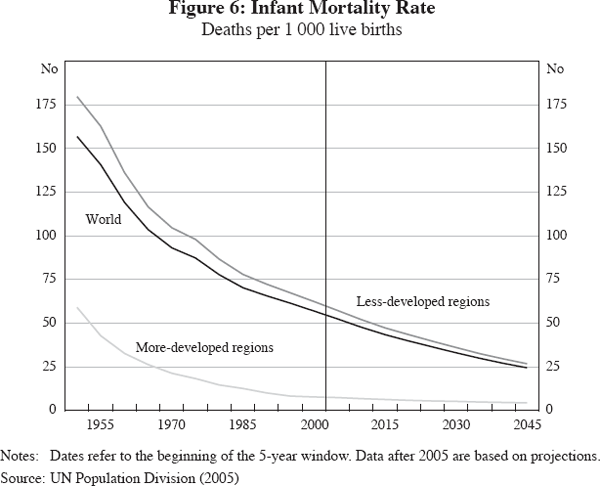
Figure 7 addresses a widely discussed issue relevant to infant and child mortality: ‘missing women’. Perhaps because of the selective abortion of female foetuses or because of female infanticide, there is a severe exaggeration in a few countries of the usual pattern of boys aged 0–4 outnumbering young girls of the same ages.
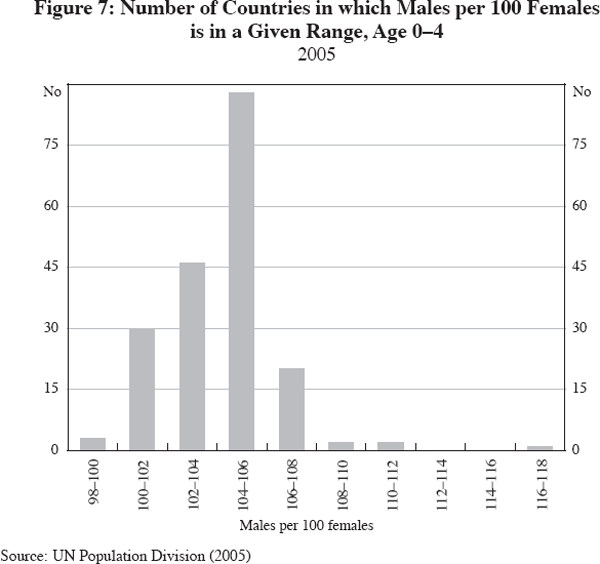
2.4 Life expectancy and longevity
For the world as a whole, life expectancy increased from 47 years in 1950–1955 to 65 years in 2000–2005. It is projected to rise to 75 years by the middle of this century, with considerable disparities between the wealthy developed countries, at 82 years, and the less-developed countries, at 74 years (see Figure 8). As a result of the global decline in fertility, and because people are living longer, median age is rising (see Figure 9). The proportion of the elderly in the total population is rising sharply. The number of people over the age of 60, currently around half the number of those aged 15–24, is expected to reach 1 billion (overtaking the 15–24 age group) by 2020. It is projected to reach almost 2 billion by 2050. The proportion of individuals aged 80 or over is projected to rise from 1 per cent to 4 per cent of the global population by 2050. (Figure 10 shows the history and projections for the actual number of individuals aged 80 or above.) Population ageing is occurring in both developed and developing countries, although more rapidly in the former. In the developed world, the proportion of people aged 60 or over will increase from 20 to 32 per cent by 2050. In the developing world, it will rise from 8 to 20 per cent. There are gender differences in life expectancy. Figure 11 shows that life expectancy for women tends to be around 4 to 6 years longer than for men, although there is considerable variation across countries.
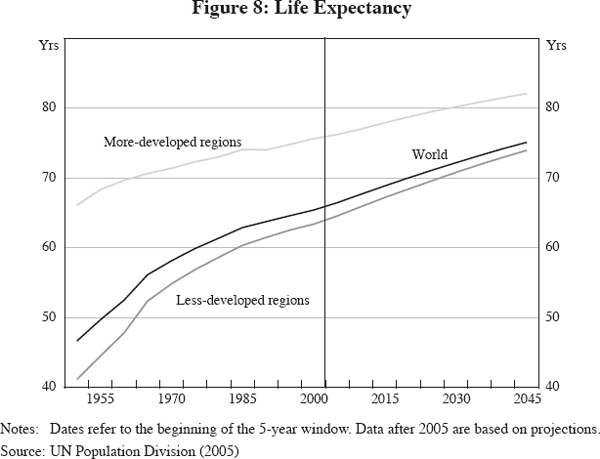

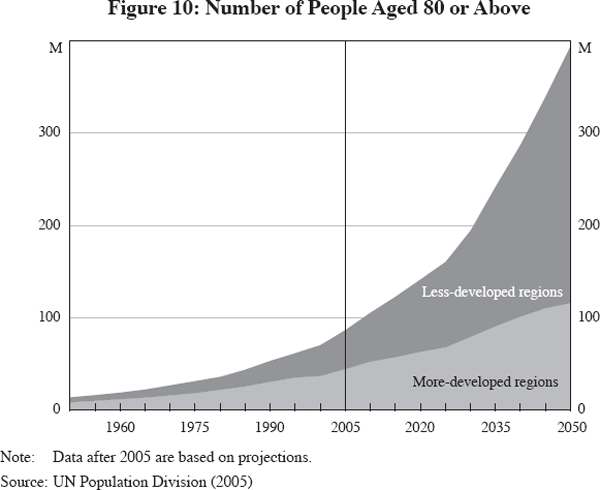
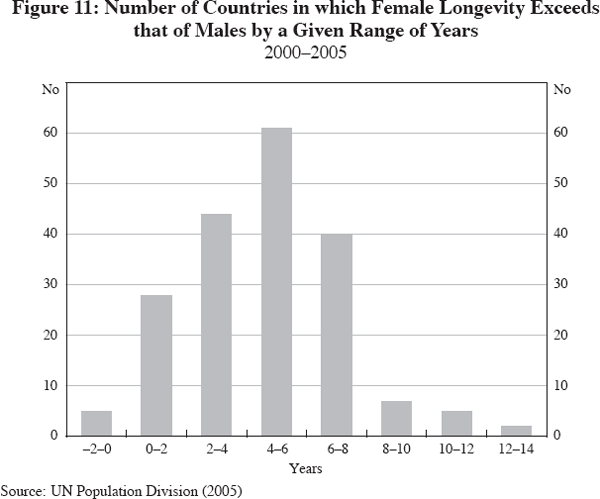
The positive correlation between life expectancy and income, which was first discussed in detail by Preston (1975), is one of the most central relationships in the fields of international health and development. Preston observed the strong, positive relationship between national income levels and life expectancy in poorer countries, though the relationship is nonlinear as life expectancy levels in richer countries are less sensitive to variations in average income. Preston also noted that life expectancy is increasing over time at all income levels. Although the basic facts set out by Preston are generally accepted, the mechanisms that lie behind the relationships and the policy implications we can draw from them are still disputed. Bloom and Canning (forthcoming) discuss Preston's paper in detail.
2.5 Age distribution: working-age population
Baby booms have altered the demographic landscape in many countries. As the experiences of several regions during the past century show, an initial fall in mortality rates creates a boom generation because high survival rates lead to more people at young ages than in earlier generations. Fertility rates fall subsequently, as parents realise they do not need to produce as many children to reach their desired family size, or as desired family size diminishes for other reasons. When fertility falls and the baby boom stops, the age structure of the population then shows a ‘bulge’ – the baby-boom-age cohort – created by the nonsynchronous falls in mortality and fertility. As this cohort works its way through the age structure of the population, it represents a share of the population larger than the share represented by the cohorts that precede or follow it (see Figure 12).

The baby boom creates particular challenges and opportunities for countries. In its youth, it is a large cohort to be educated. Jimenez and Murthi (2006), in addressing the challenges of a large youth cohort (ages 12–24), stress the importance for long-term economic growth of investing in education and health of the young and the need to ease entry into the labour market for this group. Once of age to enter the labour force, the baby boom generation represents an unusually large working-age (approximately ages 15–64) population, which offers the prospect of a ‘demographic dividend’. Lee and Mason (2006) describe two aspects of the demographic dividend: falling fertility, leading to more workers per capita and therefore potentially more resources to devote to development and to family welfare, and extra savings generated when people expect a longer retirement period. (See also Bloom, Canning and Sevilla 2002.)
2.6 Migration
Migration also alters population patterns. Globally, 191 million people live in countries other than the one in which they were born. On average, during the next 45 years, the United Nations estimates that over 2.2 million individuals will migrate annually from developing to developed countries (see Figure 13). (The UN estimates regarding future migration are not very informative, a reflection of the inherent difficulty of constructing accurate projections of migration flows.) According to the UN Population Division, the United States will receive by far the highest number of immigrants (1.1 million a year), and China, Mexico, India, the Philippines and Indonesia will be the main sources of emigrants.
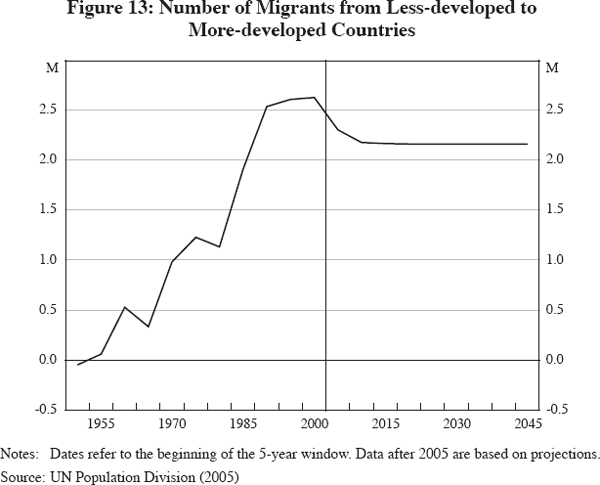
Several factors affect migration from developing to developed countries. A significant number of working-age people in developing countries are underemployed relative to the opportunities they perceive in developed countries. At the same time, developed countries face a declining share of working-age people and a growing number of elderly who need care, creating more opportunities for immigrants. Because migrants are disproportionately of working age, migration can affect the age distribution in both sending and receiving countries. The ratio of workers to dependents will tend to rise more slowly in sending countries and decline more slowly in receiving countries than it otherwise would. Williamson (2006) provides an economic explanation of the emigration life-cycle. First, people are too poor to emigrate; this is the ‘migration poverty trap’. As wealth increases and demographic booms begin, more people are able to emigrate and more are driven to emigrate. Emigration later subsides in response to remittances, industrialisation, conditions improving at home, and there being relatively fewer workers. In the case of Europe, as transport and industrialisation spread within the continent, the poorer countries joined the richer ones in sending migrants to the Americas.
2.7 Urbanisation
In both developed and developing countries, there has been a huge movement from rural to urban areas since 1950 (see Figure 14). Less-developed regions, in aggregate, have seen their population shift from 18 per cent urban in 1950 to 44 per cent in 2006, while the corresponding figures for developed countries are 52 per cent to 75 per cent. This move toward urban areas – and the concomitant urbanisation of areas that were formerly peri-urban or rural – is consistent with the shift that nearly all countries have experienced in moving from agricultural economies to industrial and service-based economies.
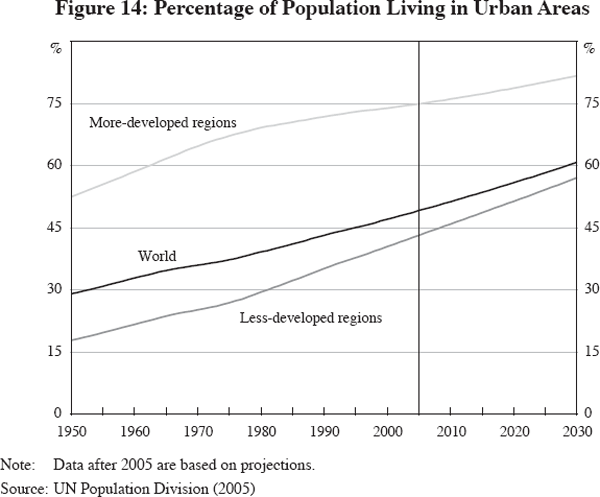
The existence and growth of megacities (that is, those with 10 million or more residents) is a late-20th century phenomenon that has created new problems. There were 20 such cities in 2003, 15 in developing countries. Tokyo is by far the largest, with 35 million people, followed by (in descending order) Mexico City, New York, São Paulo and Mumbai (all with 17 to 19 million residents). All cities allow for economies of scale and provide a broad mix of people and activities, making them centres of economic growth and activity. These characteristics account, in some measure, for their attractiveness. However, as continued movement to urban areas leads to megacities, these factors seem to be countered in part by problems that arise in the areas of transportation, housing, air pollution and waste management. The conditions in megacities may also exacerbate socioeconomic disparities.
3. The Effect on Economies – Historical Background
Demographic change is consequential with respect to economic and social development. The economic consequences of population growth, in particular, have long been the subject of debate.
It was first believed that population growth would lead to the exhaustion of resources. In 1798, Thomas Malthus, perhaps the first of the ‘population pessimists’, argued that the world's resources would be unable to keep pace with population growth. Food production would expand more slowly than population, and many would lose out in the competition for food. Such thinking held sway well into the 20th century. In 1968, Paul Ehrlich predicted: ‘The battle … is over. In the 1970s … hundreds of millions of people are going to starve to death’ (Ehrlich 1968, p xi). In the early 1970s, studies by the US National Academy of Sciences and the United Nations also predicted negative effects of population growth.
Not until the late 20th century did other arguments become popular. In the last 30 years of the 20th century, per capita incomes rose by two-thirds as global population doubled. This prompted some to ask whether, far from being a hindrance to growth, population expansion might in fact assist it. In the 1960s, it was proposed that population growth aided economic development by spurring technological and institutional innovation and increasing the supply of human ingenuity. Simon Kuznets (1967), Julian Simon (1981) and Ester Boserup (1981) were the leaders among the ‘population optimists’. Kuznets argued that larger societies can take advantage of economies of scale and are better-equipped for trade. Simon showed that the prices of natural resources decline as growing populations, complete with a greater stock of human ingenuity, make the technological improvements necessary to respond to increasing demand. Boserup presented compelling historical evidence of the pressure that population growth puts on societies to create new solutions in the face of resource constraints. The Green Revolution, for example, where new, high-yield crops dramatically increased food production in much of the developing world, occurred in part as a response to population growth. Although the optimists did not believe population growth would automatically lead to economic advances, they saw that favourable policies could help translate increases in population into greater wealth.
Population neutralism became the predominant school of thought in the 1980s and 1990s. Advocates of this position (Bloom and Freeman 1986; Kelley 1988) took the optimists' observation that the consequences of population growth depended largely on the policy environment a step further. Population neutralism was based on empirical research showing little correlation between the growth rate of income per capita and the rate of population growth. In other words, population growth by itself has no effect on economic performance. Other factors such as openness to trade, educational attainment and the quality of institutions determine whether economic progress can keep pace with population expansion. Although fast-growing populations tend to experience slower economic growth, when these other factors are taken into account, the negative impact of population expansion disappears.
Recently, population neutralism is giving way to a more fine-grained view of the effects of population dynamics in which demographic change does affect economic development. Economists and demographers now point to both the accounting effects and the behavioural effects of changes in population size and structure.
4. The Effect on Economies – Some New Thinking
4.1 Accounting effects
Some of the effects of population change on economic growth result from ‘accounting’ effects. Accounting effects assume constant behaviour – in marriage, labour participation or other decisions – within age and other demographic groups, but allow for changes in the relative size of those groups to influence overall outcomes. For example, holding age- and sex-specific labour force participation rates constant, we can see how a change in the age structure affects total labour supply.
As a country's baby boom generation ages, for a time it constitutes a large cohort of working-age individuals and, later, a large cohort of elderly people. The span of years represented by the boom generation (which determines how quickly this cohort moves through the age structure) and the size of the population bulge vary greatly from one country to another. But in all circumstances, there are reasons to think that a very unstable age structure has economic consequences. A historically high proportion of working-age individuals in a population means that, potentially, production can increase relative to consumption, and with more workers per capita, GDP per capita can receive a boost.
Life-cycle patterns in savings also come into play as a population's age structure changes. People save more during their working-age years. If the working-age cohort is especially large compared to other age groups, savings per capita will increase.
4.2 Behavioural effects
Declining rates of adult mortality and the movement of large cohorts through the global population pyramid will lead to a massive expansion in the proportion of elderly in the world population. Some simple economic projections show catastrophic effects of this ageing. These projections tend to be based on an ‘accounting’ approach, which assumes that age-specific behaviour remains unchanged and ignores the potentially significant effects of behavioural change.
The ageing of the baby boom generation potentially promotes labour shortages, creating upward pressure on wages and downward pressure on the real incomes of retirees. It is likely that workers will adjust their behaviour in response to these pressures, resulting in increased labour force participation, longer working lives and possibly the immigration of workers from developing countries. In addition, Bloom, Canning and Moore (2004) find that health and longevity improvements tend, in theory, to increase individuals' desired age of retirement. In practice, however, mandatory retirement and other disincentives to work at older ages lead people to anticipate longer periods of retirement rather than longer working lives (Bloom, Canning, Moore et al 2006; Bloom et al, forthcoming). In response, national saving rates tend to rise (Bloom, Canning and Graham 2003).
Child mortality declines can also have behavioural effects, particularly for women, who are likely to be the primary caregivers for children. When fertility has fallen in response to a decrease in child mortality, more women are able to participate in the workforce, further boosting the labour supply.
5. Empirical Evidence
Demographic change is absent from many macroeconomic analyses that aim to explain cross-country differences in economic growth and poverty reduction. Yet several empirical studies show the importance of demographics in understanding economic development.
5.1 East Asia's baby boom
East Asia's remarkable economic growth in the past half-century coincided closely with demographic change in the region. As infant mortality fell from 181 to 34 per 1,000 births between 1950 and 2000, fertility fell from around 6 to 2 children per woman. The lag between falls in mortality and fertility created a baby boom generation. Between 1965 and 1990, the region's working-age population grew nearly four times faster than the dependent population. Several studies have estimated that this demographic shift was responsible for one-third of east Asia's economic growth during the period (that is, the ‘demographic dividend’). (See Bloom and Williamson 1998; Bloom, Canning and Malaney 2000.)
5.2 Labour supply and the Celtic tiger
From 1960 to 1990, the growth rate of income per capita in Ireland was approximately 3.5 per cent per annum. In the 1990s, it jumped to 5.8 per cent, well in excess of any other European economy. Demographic change contributed to the country's economic surge. In the decade following the legalisation of contraceptives in 1979, Ireland saw a sharp fall in the crude birth rate. This led to decreasing youth dependency and a rise in the working-age share of the total population. By the mid 1990s, the dependency burden in Ireland had dropped to a level below that in the United Kingdom.
Two additional demography-based factors in Ireland helped fuel economic growth by increasing labour supply per capita. First, although male labour force participation rates remained fairly static, the period from 1980 to 2000 saw a substantial increase in female labour force participation rates, particularly in the 25–40 year-old age group. Although one would expect rapid economic growth to encourage female labour participation, it seems likely that some of the increase can be attributed to the availability of contraception and women's increased freedom to choose between working and rearing children. Second, Ireland historically had high levels of outward migration of young adults (around 1 per cent of the population per year), because its economy was unable to absorb the large inflows of young workers created by its high fertility rate. The loss of these young workers exacerbated the problem of a high youth-dependency rate. The decline in youth-cohort sizes and rapid economic growth of the 1990s led to a reversal of this flow, resulting in net in-migration of workers, made up partly of return migrants and also, for the first time, substantial numbers of foreign immigrants (see Bloom and Canning 2003).
5.3 Continued high fertility in sub-Saharan Africa
Demographic change of a very different type can account for slow economic development. Much of sub-Saharan Africa remains stalled at the first stage of a demographic transition.[3] Fertility rates actually increased a bit during the 1950s and through the 1970s and only recently have begun a slow fall. As swollen youth cohorts have entered the labour force, an inadequate economic policy environment in most countries has prevented many young people from engaging in productive employment. Large dependent populations (in this case, of children) have kept the proportion of working-age people in the total population low, making it more difficult for these economies to rise out of poverty (see Bloom and Sachs 1998).
6. Policy Implications
Rapid and significant demographic change places new demands on national and international policy-making. Transitions from high mortality and fertility to low mortality and fertility can be beneficial to economies as large baby-boom cohorts enter the workforce and save for retirement. Rising longevity also affects the incentives to save for old age, which can affect investment, international capital flows and interest rates.
The ability of countries to realise the potential benefits of the demographic transition and to mitigate the negative effects of ageing depends crucially on the policy and institutional environment. Attention to the following areas is likely to be key in developing effective policy to deal with the effects of demographic change.
6.1 Health
Recent evidence indicates that good health may be an important factor in economic development (see Bloom, Canning and Sevilla 2004). Health improvements – especially among infants and children – often lead to declines in fertility. Focusing on the diseases of childhood can therefore increase the likelihood of creating a boom generation and the positive economic effects a boom can generate (see Bloom, Canning and Weston 2005). Countries wishing to accelerate fertility declines may benefit from improving access to family planning services and education about fertility decisions.
6.2 Education
Workers are better able to contribute to economic growth if they have received an effective education. East Asia capitalised on its baby boom generation by providing high-quality education, including both general schooling and technical skills, which equipped them as workers to meet the demands of an ever-changing labour market. Ireland also gained from its baby boom by introducing free secondary schooling and expanding tertiary education.
6.3 Labour market institutions
Restrictive labour laws can limit a country's ability to benefit from demographic change, particularly where these laws make it difficult to hire and fire workers or to work part-time.[4] Restrictions on immigration are also of concern, as they hold down the labour supply. Immigration is a political hot potato in many countries, but economic incentives to lower barriers to immigration are likely to grow stronger as populations in developed countries age. International outsourcing, another controversial subject, may also be an increasingly important means of meeting the demand for labour.
6.4 Trade
One means by which east-Asian countries provided productive opportunities to their baby boom cohorts was by carefully opening up to international trade. The opportunity to export provides an outlet for the product of a large cohort. Bloom and Canning (2004) found that open economies benefit much more from demographic change than the average, and that closed economies do not derive any statistically significant benefit from changes in the age structure.
6.5 Retirement
Population ageing requires increased savings to finance longer retirements (especially if governments maintain current policies that discourage the conversion of greater longevity into longer working lives). This will affect financial markets, rates of return and investment. As more people move into old age, health care costs are likely to spiral upward, with the expansion of health care systems and growth in long-term care for the elderly. (However, Bryant and Sonerson (2006) caution that an ageing population is not the main driver of rising expenditures on health, showing that non-demographic factors are more substantial drivers of rising health expenditures than demographic ones.) As non-tradable, labour-intensive sectors with a low rate of technical progress, health care and elder care may affect the structure of the economy and potentially slow measured growth. Existing social security systems may hamper the ability of individuals to contribute to the financing of their retirement, as many of these systems penalise individuals who work beyond a fixed retirement age. As Turner (2006) explains, demographic factors play a central role in determining the potential viability of all pension systems, both fully funded and pay-as-you-go plans. Recent work in Australia by Kulish, Smith and Kent (2006) suggests that changes in fertility and longevity, functioning jointly, tend to increase the ratio of capital to labour inputs, and that, on average, people would still choose to spend a similar portion of their lives in retirement as before these changes.
7. Thinking Far Ahead: Whither the Human Life Span?
A discussion that pertains centrally to increases in life expectancy and that touches on retirement naturally leads to the question of the human life span. How long are people likely to live in the coming decades, and are the anticipated changes likely to bring new issues to the fore?
In most of the world, life expectancy has risen sharply during the past two centuries. Children born today can expect to live for many decades longer than their ancestors born in the 19th or early 20th centuries. In Japan, life expectancy at birth is now 82 years, and other regions have also made great progress as medical and public health advances, improved nutrition and behavioural changes encouraged by improved education have combined to reduce the risk of death at all ages.
Fries (1983) suggests that the human life span is more or less fixed at a certain age and unlikely to change over time. According to this view, an accumulation of inherited diseases express themselves in the post-reproductive years, during which individuals' survival confers no evolutionary benefit on their descendants, effectively maintaining a ceiling on life expectancy. Ronald Lee (2003), however, proposes an evolutionary mechanism through which the human life span may increase. He argues, essentially, that the children of individuals who are genetically disposed to long life benefit from their parents' and grandparents' longevity, mainly through intergenerational transfers (for example, time spent nurturing children). This mechanism has acted against the accumulation of inherited diseases at the older ages and has tended to shape the human genome in a manner that is likely to be more responsive to the life-prolonging efforts of modern science.
Whether or not the human life span changes over time may have important implications for societies and economies. If it remains steady at around 85 years, the fraction of people living beyond that age is unlikely to grow significantly or rapidly. If it increases, on the other hand, societies may face a number of new challenges. In one plausible scenario, health care costs will rise with increasing numbers of very old individuals; pension and social security payments will come under increasing pressure; the dependency ratio will shift, leaving relatively smaller working-age populations with an increased number of elderly dependents to support; and societies will have to adapt to the social and cultural impacts of the new demographic realities. But even if life spans increase significantly, it is possible that most of these predictions will not come to pass. Fries discusses a phenomenon known as ‘the compression of morbidity’ – meaning that the illnesses associated with old age may come to arise sufficiently later in life so that, even with increased life spans, the elderly may have fewer years during which they are dependent on working-age people. If this is correct, the predictions above will be incorrect, particularly if people choose to retire later or save more early in life.
Continuing increases in life expectancy in low-mortality populations have led some demographers to forecast further gains. They believe that scientific advances will continue to combine with behavioural changes to yield further life expectancy gains in the future. Manton, Stallard and Tolley (1991), for example, estimate that populations with extremely healthy lifestyles – that is, with an absence or near-absence of risk factors such as smoking, alcohol and obesity, and the presence of health-promoting behaviours such as a healthy diet and exercise – could achieve a life expectancy of between 95 and 100 years. Oeppen and Vaupel (2002) found that death rates among the very old in Sweden and throughout the industrial world fell substantially in the last century, and at an accelerating pace, reflecting bona fide life-span improvements. They forecast that life expectancy at birth in low-mortality countries will rise to 100 years by 2060. Along the same lines, Preston (1996) observes that 60 per cent of the life expectancy increase in the United States since 1950 was due to mortality declines in people over the age of 50. Li and Lee (2005) estimate that life expectancy in the United States will rise from a 1996 figure of 76.3 to 84.9 by 2050, with that in Japan rising from 80.5 to 88.1.
Others have reached different conclusions. Olshansky and Carnes (1994) question the models used by demographers which underpin predictions that life expectancy will increase dramatically; Olshansky, Carnes and Désesquelles (2001) predict that life expectancy at birth will not surpass 85 years. Death rates, they argue, would not fall sufficiently for life expectancy to rise rapidly, and earlier increases were driven largely by dramatic reductions in infant and child mortality, which could not recur. Perhaps more importantly, they see no reason why the future should necessarily mirror the past – new threats to health such as influenza pandemics, antibiotic resistance and obesity (discussed subsequently in Preston 2005) could reverse gains made in recent decades; technological improvements could stall and the drugs needed to counter the diseases of ageing might not be found; and environmental disasters, economic collapse or war could derail health systems at the same time as weakening individuals' ability to protect their own health.
The debate continues, and many questions remain unanswered. What will be the effect on the human life span of advances in genetics? Will anti-ageing technologies emerge to make the human body more robust for longer? Will wealthy societies succumb to damaging obesity epidemics or to new infectious diseases such as avian flu? Will economic meltdown take away the wealth that has contributed so much to improvements in health? Or will wars result in massive premature mortality, and thereby render the average life span a far less compelling issue?
8. Looking to the Future
What can we expect in the next half-century? Based on the indicators that are available, we can make a few points.
- All signs suggest that there will be continued but slowing population growth. This continued growth will result in the addition of roughly 3 billion people to the world population, before it stabilises around 2050 at about 9 billion. Managing this increase will be an enormous challenge, and the economic consequences of failing to do so could be severe.
-
The world's population is ageing, and the growth in the sheer number of elderly
people will be huge. The United Nations predicts that 31 per cent of China's
population in 2050 – 432 million people – will be aged 60 or over.
The corresponding figures for India are 21 per cent and 330 million (see Figure 15).
No longer can ageing be thought of as a developed-world phenomenon. (Further
comparison of China and India's demographic development as it has affected
their economic development can be found in Bloom, Canning, Hu et al
2006.)
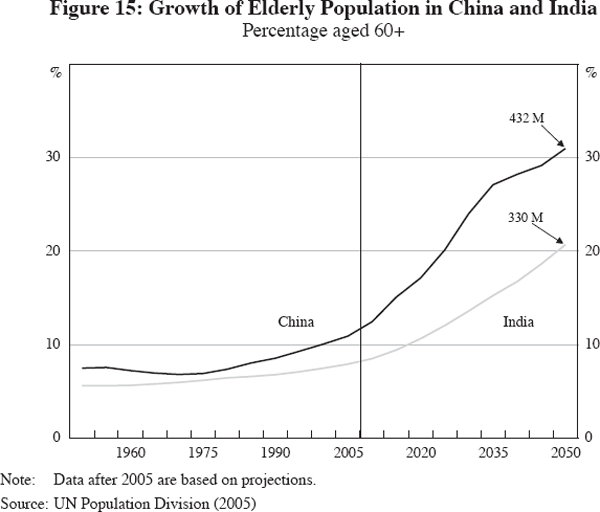
- International migration will continue, but the extent is unclear. The pressures that encourage people to migrate – above all the lure of greater economic well-being in the developed countries – will undoubtedly persist, but the strength of countervailing policy restrictions that could substantially staunch the flow of migrants is impossible to predict.
- Urbanisation will continue, but here, too, the pace is impossible to predict. Greater economic opportunities in the cities will surely continue to attract migrants from rural areas, but environmental and social problems may stymie growth.
Although demographic changes are, for the most part, easier to predict than economic changes, the big-picture outlook is nonetheless unclear. The uncertainties are similar to those we cited regarding possible changes in the human life span. Will an outbreak of avian flu or another disease become pandemic, killing many millions and decimating economies? What happens if these diseases are, or become, resistant to existing drugs? Conversely, scientific advances in areas such as genomics, contraceptive methods, or vaccines for diseases such as AIDS or malaria could save and improve millions of lives. Global warming and other environmental changes, or large-scale war, could completely alter the context of demographic and economic predictions. Millions of refugees, from any cause, could lead demographic predictions to be far off the mark, and could, of course, lead to upheavals that would dwarf the importance of the analysis offered here.
Appendix A: Notes on Source, Country Groups, Coverage Period, Definitions and Assumptions
Source
All data and charts are taken directly from, or calculated on the basis of UN Population Division (2005). See <http://www.un.org/esa/population/publications/WPP2004/2004EnglishES.pdf> for the Executive Summary of UN Population Division (2005) (including the assumptions).
Definition of country groups
The UN defines ‘more-developed regions’ as ‘all regions of Europe plus Northern America, Australia/New Zealand and Japan’. ‘Less-developed regions’ means ‘all regions of Africa, Asia (excluding Japan), Latin America and the Caribbean plus Melanesia, Micronesia and Polynesia’.
The list of ‘more-developed’ countries consists of the following: Albania, Australia, Austria, Belarus, Belgium, Bosnia and Herzegovina, Bulgaria, Canada, Channel Islands, Croatia, the Czech Republic, Denmark, Estonia, Finland, France, Germany, Greece, Hungary, Iceland, Ireland, Italy, Japan, Latvia, Lithuania, Luxembourg, Malta, the Netherlands, New Zealand, Norway, Poland, Portugal, the Republic of Moldova, Romania, the Russian Federation, Serbia and Montenegro, Slovakia, Slovenia, Spain, Sweden, Switzerland, TFYR Macedonia, Ukraine, the United Kingdom and the United States. All other countries are classified by the UN as ‘less-developed’.
Coverage period
The source presents data for 1950–2050. The United Nations presents some data for exact years (1950, 1955, etc) and other data for five-year periods (1950–55, 1955–60, etc). For the former, projections are made for 2010–2050; for the latter, for 2005–2010 to 2045–2050. For urban population shares, projections extend only to 2030. In each case, 1 July is the reference date. Data presented for exact years are: population, population by any specific age group, population by sex and the urban population share. Variables presented for five-year periods are: crude birth rate, crude death rate, total fertility rate, infant mortality rate, life expectancy, population growth rate, migration rate and number of migrants.
Definitions
The source document uses the following definitions:
Total fertility: children per woman
Crude birth rate: births per thousand population
Crude death rate: deaths per thousand population
Infant mortality rate: infant deaths per thousand live births, for both sexes combined
Life expectancy: expectation of life at birth for both sexes combined (years)
Population growth rate: average annual rate of population change (per cent)
Migrant numbers: net number of migrants, both sexes combined (thousands) – defined such that a positive number of migrants means that immigrants outnumber emigrants
Migration rate: crude net migration rate (net migrants per thousand population) – defined such that a positive rate means that immigrants outnumber emigrants
Percentage urban population: there is no simple definition for ‘urban’ in UN data. Demographic, administrative, and economic criteria used to report figures on urbanisation differ across countries.
In addition, we have defined two age groups, as follows:
Working age: 15–64
Non-working age: 0–14 and 65+
Assumptions
Fertility
The UN uses several differing assumptions about future fertility in making its projections. For the data and figures in this paper, we have used the UN's ‘medium-fertility variant’ in all instances in which more than one variant is available: total fertility rate, crude birth rate, crude death rate, population (for all age groups), population growth rate, migration rate and number of migrants.
For the medium-fertility variant, the UN assumes for all countries that fertility will gradually converge to 1.85 children per woman. It does not assume that countries will necessarily reach that level by 2050. For high- and medium-fertility countries (that is, those with total fertility at or below 2.1 children per woman in 2000–2005), projections are built on the experience of all countries that experienced fertility declines during the past half-century. If a country's fertility rate is projected to fall to 1.85 before 2050, the UN model assumes it will then remain at that level. Projections are not done mechanistically; they are always checked against recent trends in a specific country. In some instances, these recent trends require an adjustment in projections for the coming five or ten years, after which time projections revert to the basic fertility projection model. For low-fertility countries whose fertility rate is currently below 1.85, the model used by the UN assumes that fertility in the coming five to ten years will follow recent trends and will then increase at a rate of 0.07 children every five years.
Mortality
The UN also makes assumptions about future mortality rates, which affect most of the data in the figures in this paper. UN projections take into account recent sex-specific trends and are based on the expectation that life expectancy will rise more slowly in countries that have already reached a fairly high level. For those indicators for which the UN provides data specific to various possible courses of the HIV/AIDS epidemic, we have used only the ‘normal mortality assumption’ (which uses a model that takes HIV/AIDS into consideration and, for countries with high levels of the disease, projects a ‘slowdown in the reduction of general mortality risks not related to HIV/AIDS’).
Migration
For migration numbers and rates, the UN assumes for most countries that migration patterns will change very slowly after the period 2010–2015, compared with the speed at which such patterns changed in the past. Projections are based on past trends and take into account countries' current policies regarding international migration.
Footnotes
David E Bloom is Professor of Economics and Demography at the Harvard School of Public Health (dbloom@hsph.harvard.edu). David Canning is Professor of Economics and International Health at the Harvard School of Public Health (dcanning@hsph.harvard.edu). The authors thank the John D. and Catherine T. MacArthur Foundation, the William and Flora Hewlett Foundation and the National Institute of Aging for supporting much of the research on which this paper is based. The authors also thank Larry Rosenberg for his assistance with this work. [1]
Notes on sources used, United Nations projections and definitions of demographic indicators appear in Appendix A. [2]
Some African nations – notably Zimbabwe and those in southern Africa including Namibia, Botswana and South Africa – are beginning to experience faster fertility declines. [3]
There are also arguments on the other side of this issue that deserve consideration. For example, in many countries, labour unions have led to improved living conditions, including for non-members. The same might also be said of minimum wages even if, in some circumstances, they have constrained some aspects of economic development. [4]
References
Bloom DE and D Canning (2003), ‘Contraception and the Celtic Tiger’, Economic and Social Review, 34(3), pp 229–247.
Bloom DE and D Canning (2004), ‘Global Demographic Change: Dimensions and Economic Significance’, in GH Sellon Jnr (ed), Global Demographic Change: Economic Impacts and Policy Challenges, Proceedings of a Symposium Sponsored by the Federal Reserve Bank of Kansas City, Jackson Hole, pp 9–56.
Bloom DE and D Canning (forthcoming), ‘The Preston Curve 30 Years On: Still Sparking Fires’, International Journal of Epidemiology.
Bloom DE, D Canning and B Graham (2003), ‘Longevity and Life-Cycle Savings’, Scandinavian Journal of Economics, 105(3), pp 319–338.
Bloom DE, D Canning, L Hu, Y Liu, A Mahal and W Yip (2006), ‘Why Has China's Economy Taken Off Faster than India's?’, paper presented at the 2006 Pan Asia Conference on ‘Challenges of Economic Policy Reform in Asia’, Stanford University, 1–3 June.
Bloom D, D Canning and P Malaney (2000), ‘Demographic Change and Economic Growth in Asia’, Population and Development Review, 26, pp 257–290.
Bloom DE, D Canning, R Mansfield and M Moore (forthcoming), ‘Demographic Change, Social Security Systems, and Savings’, Journal of Monetary Economics.
Bloom DE, D Canning and M Moore (2004), ‘The Effect of Improvements in Health and Longevity on Optimal Retirement and Saving’, NBER Working Paper No 10919.
Bloom DE, D Canning, M Moore and Y Song (2006), ‘The Effect of Subjective Survival Probabilities on Retirement and Saving in the U.S.’, paper presented at a conference on ‘Population Aging, Intergenerational Transfers, and the Macroeconomy’, Nihon University Population Research Institute, Tokyo, 26–28 June.
Bloom DE, D Canning and J Sevilla (2002), ‘The Demographic Dividend: A New Perspective on the Economic Consequences of Population Change’, RAND Corporation Monograph Report No MR-1274.
Bloom DE, D Canning and J Sevilla (2004), ‘The Effect of Health on Economic Growth: A Production Function Approach’, World Development, 32(1), pp 1–13.
Bloom DE, D Canning and M Weston (2005), ‘The Value of Vaccination’, World Economics, 6(3), pp 15–39.
Bloom DE and RB Freeman (1986), ‘The Effects of Rapid Population Growth on Labor Supply and Employment in Developing Countries’, Population and Development Review, 12(3), pp 381–414.
Bloom DE and JD Sachs (1998), ‘Geography, Demography, and Economic Growth in Africa’, Brookings Papers on Economic Activity, 2, pp 207–295.
Bloom DE and JG Williamson (1998), ‘Demographic Transitions and Economic Miracles in Emerging Asia’, World Bank Economic Review, 12(3), pp 419–455.
Boserup E (1981), Population and Technological Change: A Study of Long-Term Trends, University of Chicago Press, Chicago.
Bryant J and A Sonerson (2006), ‘Gauging the Cost of Aging’, Finance & Development, 43(3). Available at <http//www.imf.org/external/pubs/ft/fandd/2006/09/index.htm>.
Ehrlich PR (1968), The Population Bomb, Sierra Club-Ballantine Books, New York.
Fries JF (1983), ‘The Compression of Morbidity’, The Milbank Memorial Fund Quarterly, 61(3), pp 397–419.
Jimenez EY and M Murthi (2006), ‘Investing in the Youth Bulge’, Finance & Development, 43(3). Available at <http//www.imf.org/external/pubs/ft/fandd/2006/09/index.htm>.
Kelley AC (1988), ‘Economic Consequences of Population Change in the Third World’, Journal of Economic Literature, 26(4), pp 1685–1728.
Kulish M, K Smith and C Kent (2006), ‘Ageing, Retirement and Savings: A General Equilibrium Analysis’, Reserve Bank of Australia Research Discussion Paper No 2006-06.
Kuznets S (1967), ‘Population and Economic Growth’, Proceedings of the American Philosophical Society, 111(3), pp 170–193.
Lee RD (2003), ‘Rethinking the Evolutionary Theory of Aging: Transfers, Not Births, Shape Senescence in Social Species’, Proceedings of the National Academy of Sciences of the United States of America, 100(16), pp 9637–9642.
Lee RD and A Mason (2006), ‘What Is the Demographic Dividend?’, Finance & Development, 43(3). Available at <http//www.imf.org/external/pubs/ft/fandd/2006/09/index.htm>.
Li N and RD Lee (2005), ‘Coherent Mortality Forecasts for a Group of Populations: An Extension’, Demography, 42(3), pp 575–594.
Manton KG, E Stallard and HD Tolley (1991), ‘Limits to Human Life Expectancy’, Population and Development Review, 17(4), pp 603–637.
Oeppen J and JW Vaupel (2002), ‘Broken Limits to Life Expectancy’, Science, 296(5570), pp 1029–1031.
Olshansky SJ and BA Carnes (1994), ‘Demographic Perspectives on Human Senescence’, Population and Development Review, 20(1), pp 57–80.
Olshansky SJ, BA Carnes and A Désesquelles (2001), ‘Prospects for Human Longevity’, Science, 291(5508), pp 1491–1492.
Preston SH (1975), ‘The Changing Relation between Mortality and Level of Economic Development’, Population Studies, 29(2), pp 231–248.
Preston SH (1996), ‘American Longevity: Past, Present, and Future’, Syracuse University, Maxwell School Center for Policy Research Policy Brief No 7/1996.
Preston SH (2005), ‘Deadweight? – The Influence of Obesity on Longevity’, The New England Journal of Medicine, 352(11), pp 1135–1137.
Simon JL (1981), The Ultimate Resource, Princeton University Press, Princeton.
Turner A (2006), ‘Pension Challenges in an Aging World’, Finance & Development, 43(3). Available at <http//www.imf.org/external/pubs/ft/fandd/2006/09/index.htm>.
UN Population Division (2005), World Population Prospects: The 2004 Revision, United Nations, New York. Available at <http://esa.un.org/unpp/>.
Williamson JG (2006), ‘Global Migration’, Finance & Development, 43(3). Available at <http//www.imf.org/external/pubs/ft/fandd/2006/09/index.htm>.